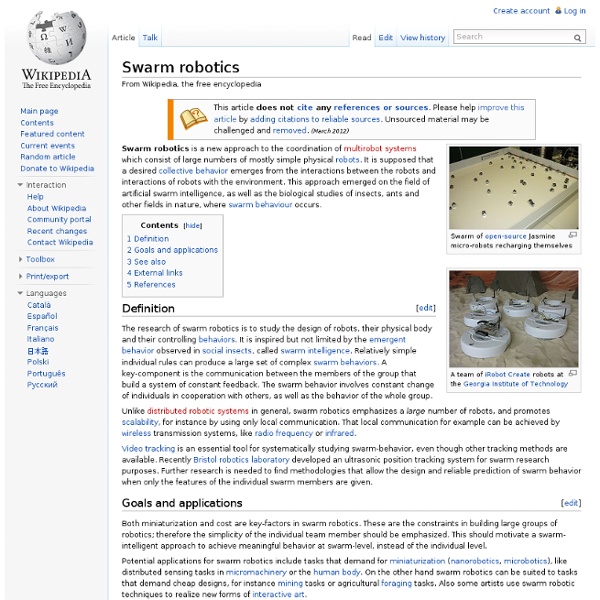Swarm robotics

Slime mould used to create first robot run by living cells | Science
Ever worried that the terrifying cyborgs that fill sci-fi stories might one day become a reality? Perhaps the latest research by Klaus-Peter Zauner of Southampton University will cause a stir: the engineer has invented a robot that is controlled by living cells. The cells in question are a specially grown type of "slime mould" that naturally shies away from light. Dr Zauner grew a star-shaped sample of the slime mould and attached it to a six-legged robot (with each point of the star attached to a leg) to control its movements. Shining white light on to a section of the single cell organism made it vibrate, changing its thickness. The work came out of a collaboration with scientists at Kobe University in Japan, who had been studying ways of using biological cells in robots. "The long-term vision that I have is that this technology we're after is going to be somewhere between living cells and molecules," he said. Using biological cells provides some autonomy to the robot's movements.
Robotic cheetah 'breaks speed record for legged robots'
6 March 2012Last updated at 06:33 ET Footage of the robot in action - courtesy Darpa A headless robot dubbed "Cheetah" has set a new world speed record, according to its owners. The US Defense Advanced Research Projects Agency said the four-legged machine achieved 18mph (29km/h) on a laboratory treadmill. The agency said the previous land speed record by a legged robot was 13.1mph. Darpa said that the project was part of efforts to develop robots designed to "more effectively assist war fighters across a greater range of missions". Darpa - which is run by the Pentagon - funded the Massachusetts robotics company Boston Dynamics to build the machine. "We plan to get off the treadmill and into the field as soon as possible," said the firm's chief robotics scientist, Alfred Rizzi, in a statement. "We really want to understand what is possible for fast-moving robots." Animal designs The robot's movements have been modelled on those of fast-running animals in the wild.
RoboJelly, the Hydrogen-Powered Robot Jellyfish
This mechanical sea creature is RoboJelly, a prototype robotic jellyfish that closely mimics the movements of the real animal. Researchers revealed their creation today by publishing a paper in the journal Smart Materials and Structures. Fueled by hydrogen and oxygen, two gases that exist in trace amounts in the ocean—and in water itself—the device could potentially power itself indefinitely under the sea to serve a host of functions, including pollution monitoring and military surveillance. Lead author of the study Yonas Tadesse, a researcher at the University of Texas at Dallas, says it’s the first underwater robot powered by hydrogen gas. The jellyfish mimic moves with artificial muscles, whose core is made of nickel–titanium, which is a shape-memory alloy (a "memory metal" that remembers the shape at which it was cold-forged and will return to that shape). "One beauty of this is that the only waste product is water," Tadesse says.
Related:
Related:



